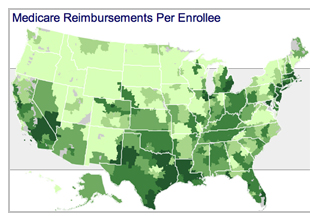Obama health agenda takes shape


Those are the headlines you are reading about the President's health care plan, now being presented to Congress in the form of his 10-year budget. (Picture from the Dartmouth Atlas Project.)
The President calls for creating a $634 billion fund, over 10 years, to cover the uninsured, paid for by rolling back the Bush tax cuts and reducing Medicare payments.
Liberals are going hip hip hooray. Conservatives should know a big source of savings will be cutting out the reimbursement advantages of private Medicare Advantage plans, created under the Bush Administration.
But are those Medicare savings really there? A study in today's New England Journal of Medicine suggests they are. And conservatives may be pleased to know they are to be found mainly in New York and California.
The work was done by the Dartmouth Atlas of Health Care, showing Medicare costs the government twice as much in some markets as in others, a difference created not by geography but by the market.
The authors argue that the differences in growth are largely due to discretionary decisions by physicians that are influenced by the local availability of hospital beds, imaging centers and other resources-and a payment system that rewards growth and higher utilization.
The Dartmouth study recommends creation of Accountable Care Organizations to share savings among regions, and create incentives for frugality. Its white paper says the Obama Administration can improve care without increasing cost.
The group also fisked a December study claiming the availability of more specialists means higher quality care.
The key line from study author Eliot Fisher. "Technology doesn't drive the growth in health care spending, people do." Something to chew on.
Oh, on the map, which you can interact with here, the darker the green the more Medicare costs the taxpayer, per patient.